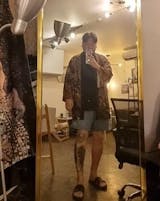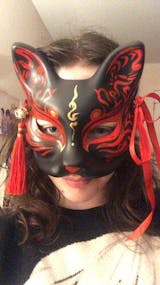I am not the type of person to write reviews but here it goes.
I really needed the clothes for an unexpected party but I chose the fast delivery option and I should say I’m impressed by their fast delivery. The product matches the pictures displayed and I’m impressed by the quality. Kudos to Eiyo Kimono.
What is a Japanese Kimono?

The Japanese have several significant traditional garments, the most prominent of which is the kimono also known as a Japanese Kimono. The kimono is worn by both men and women, and sometimes children. It enriches Japan's culture and, in many ways, has become the recognition for the Japanese. The kimono is a historically aesthetic and symbolic garment, and it has been around for several centuries in Japanese families. They are adopted into modern versions of jackets and dresses by the rest of the world due to their elegance and unique style.
Who Invented the Kimono?
Along with being an exquisite garment, the kimono also has an interesting history that catches the attention of tourists and visitors. The literal meaning for the word kimono is 'something to wear, which is quite simple and modest. However, kimonos can be grand robes worn on formal occasions, or they can be stitched from comfortable material for everyday use. Most historians disagree on when the first kimono came into existence, and the period is not confirmed yet. Despite this, it is a uniform truth in Japanese history that the kimono originated in the Heian period, stretching from 794 to 1192.
The first kimono was not a complex or luxurious garment that you see today at significant events around Japan. Indeed, it was a convenient robe that was tied together by stitching two pieces of cloth. It was easy to wear and adjust according to the size of whoever was wearing it. Soon, the garment spread through several cities, and it was customized and changed numerous times before it became the kimono that we know today. Now, the kimono is worn at all events, whether formal or informal. The cloths used for designing the kimono are also switched according to the weather. Kimonos intended to be worn in summer have lesser layers beneath them, and they are favorable in the hot weather.
Why do the Japanese Wear a Kimono?
Indeed, people in Japan do not wear the kimono as much today as they did several centuries ago. The kimono is reserved for important festivals, ceremonies, and government events that the public has to participate in. In addition to this, the kimono may be worn by female students at their graduation ceremonies. The Japanese usually spend their days in comfortable clothing such as sweatshirts, denim, t-shirts, and jackets. Western attire is common in Japan's fashion, particularly in the younger generation.
The fabric used for kimonos can be handmade or decorated by hand, depending on the price and region. Most kimonos include sashes and ribbons made of silk that look enchanting informal events. The inner layers may be crafted from linen or cotton, so they are comfortable against the skin. The kimono skirt is meant to be slightly puffed and lifted off the ground, so fabric like polyester is preferred. The colors usually indicated wealth or class status in older times, a tradition that ceased. Most kimonos today feature bright colors such as magenta, orange, and blue. For more somber events, one may wear white, gold, or green.
The kimono has remained an integral part of Japan's culture since it was initially created. This is why both men and women choose to wear the kimono instead of traditional Western clothing at their weddings and other religious events. The practice of reserving the kimono for something special enhances the value of the garment. It encourages tourists to purchase or rent a kimono for themselves, as it is the most esteemed garment among the Japanese population. Apart from this, the fashion revolving around the kimono has developed extensively over the years. Wearers now have millions of options in color, pattern, embroidery, and cloth to choose from when purchasing their kimono.
When Should You Wear a Kimono?
The kimono has a certain charm that is not present in other cultural dresses. Along with being easy to carry, it also stays in place while you walk around. The material of a kimono is stiff and sturdy enough to last through your ceremonies. Indeed, the kimono is a one-time investment that you are unlikely to regret due to the elegance and design of the dress. The kimono is a powerful cultural statement. It is also quite versatile, which means that you can alter the components of the dress according to the weather or your preferences.
The dress itself is also highly symbolic, and it represents good fortune and prosperity for the one who wears it. When a citizen or tourist wears the kimono, they pay their respects to Japan's history and culture. You can witness authentic Japanese kimonos with the proper accessories if you go to a theatre in Japan. An informal form of the kimono, called the yukata, is popular among women and children who casually wear traditional Japanese clothing. Kimono and yukata are not the same. There is a difference between a Japanese Kimono and a Yukata. It is usually worn in the summer because the fabric used for the yukata is lighter in both texture and color. Even on special occasions, you will mostly see Japanese women wearing elegant kimonos, while the men will wear informal Western attire.
Kimonos are typically popular among the older generation, who may wear the robe daily instead of Western clothing that limits their mobility and may not be as comfortable to wear. Tea ceremonies held in Japan often require participants to wear their best kimonos in a large variety of colors. Kimonos are readily available in Japan, and you can find a store that offers rentals on almost every corner. It would be best to try on several dresses before selecting one, as the patterns and colors suit everyone differently. If you are willing to invest in a luxurious kimono for all your formal events, you can get one tailored and customized according to whichever design you prefer. Koi fish are a common print on kimono dresses among young women, which symbolize success and determination, admirable traits. Cherry blossoms are also popular, and they are printed on the hem of the kimono. This design exhibits grace and looks best with darker colors fabrics.





